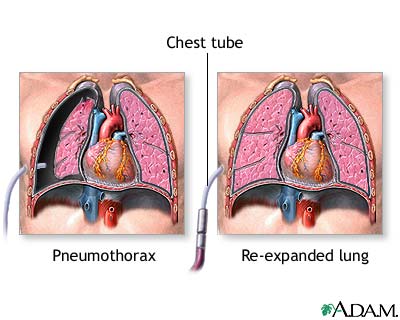Pneumothorax - definition, symptoms and treatment

What is Pneumothorax and Definition
Pneumothorax is a circumstance in which air gets in the pleural space (membrane space between the pleural linings of the lung and the thoracic cavity). Pneumothorax results in collapse of a portion of, or the entire, lung. Doctors identify different kinds of pneumothorax. They include
- spontaneous pneumothorax, in which the pneumothorax occurs for no identifiable reason or as a consequence of severe lung disease such as CHRONIC OBSTRUCTIVE PULMONARY DISEASE (COPD) or TUBERCULOSIS
- simple pneumothorax, in which air enters the pleural space and part of all of the lung collapses but there is no pressure on surrounding structures
- tension pneumothorax, in which the pneumothorax occurs and pressure continues to build in the pleural space, putting pressure on the heart and causing potentially life-threatening cardiovascular collapse
- traumatic pneumothorax, in which air enters the pleural
Symptoms of Pneumothorax
Symptoms include DYSPNEA (shortness of breath) and sudden, sharp PAIN that worsens with deep BREATHING or coughing. Some people develop CYANOSIS (bluish hue to the lips and SKIN) that indicates the body is not receiving enough oxygen. TACHYCARDIA (rapid HEART RATE), TACHYPNEA (rapid breathing), and HYPOTENSION (low BLOOD PRESSURE) are also common. The diagnostic path includes AUSCULTATION, which often reveals reduced or absent BREATH SOUNDS, and chest X-RAY, which shows the area of lung collapse.
Pneumothorax Treatment
A pneumothorax that involves only a small portion of the lung often heals itself. A larger pneumothorax requires insertion of a chest tube (done with local ANESTHESIA) to remove the air and allow the lung to reinflate. Most people who require such treatment stay in the hospital until the affected lung returns to normal function and the doctor can safely remove the chest tube. About half of people who have one episode of spontaneous pneumothorax have a subsequent episode, though most people do not experience any permanent lung damage. People who are tall and thin are most vulnerable to spontaneous pneumothorax. Spontaneous pneumothorax is also more common among people who smoke.
See also BRONCHIECTASIS.
Open discussion on the topic Pneumothorax - definition, symptoms and treatment
Similar interests
- Casino Non Aams
- Nuovi Casino
- Casinos Not On Gamstop
- UK Casinos Not On Gamstop
- Casinos Not On Gamstop
- UK Casinos Not On Gamstop
- Casino Non Aams Italia
- Slot Sites Not On Gamstop
- Meilleur Casino En Ligne
- Non Gamstop Casino Sites UK
- Meilleur Casino En Ligne
- Casino En Ligne France
- Best Non Gamstop Casinos
- Casinos Not On Gamstop
- UK Casino Not On Gamstop
- Casinos Not Signed Up To Gamstop
- Best Slot Sites UK
- Non Gamstop Casino Sites UK
- Online Casinos Nederland
- Online Casinos Nederland
- Casinos Not On Gamstop
- Best New Uk Casinos Not On Gamstop
- Casino Non Aams
- Non Gamstop Casinos UK
- Migliori Siti Casino Non Aams
- Bitcoin Casinos
- Sites De Paris Sportifs Belgique
- Bookmaker Non Aams
- Casino En Ligne
- Casino Nouveau En Ligne